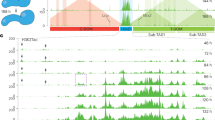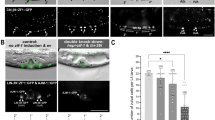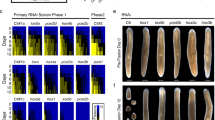Abstract
THE Hox genes are expressed in a conserved sequence of spatial domains along the anteroposterior (A/P) body axes of many organisms1. In Drosophila, position-specific signals located along the A/P axis establish the pattern of Hox gene expression2–4. In the nematode Caenorhabditis elegans, it is not known how the pattern of Hox gene expression is established. C. elegans uses lineal control mechanisms and local cell interactions to specify early blastomere identities5,6. However, many cells expressing the same Hox gene are unrelated by lineage, suggesting that, as in Drosophila, domains of Hox gene expression may be defined by cell-extrinsic A/P positional signals. To test this, we have investigated whether posterior mesodermal and ectodermal cells will express their normal posterior Hox gene when they are mispositioned in the anterior. Surprisingly, we find that correct Hox gene expression does not depend on cell position, but is highly correlated with cell lineage. Thus, although the most striking feature of Hox gene expression is its positional specificity, in C. elegans the pattern is achieved, at least in part, by a lineage-specific control system that operates without regard to A/P position.
This is a preview of subscription content, access via your institution
Access options
Subscribe to this journal
Receive 51 print issues and online access
$199.00 per year
only $3.90 per issue
Buy this article
- Purchase on Springer Link
- Instant access to full article PDF
Prices may be subject to local taxes which are calculated during checkout
Similar content being viewed by others
References
McGinnis, W. & Krumlauf, R. Cell 68, 283–302 (1992).
Lawrence, P. A. & Morata, G. Cell 78, 181–190 (1994).
McGinnis, W. et al. Adv. Genet. 27, 363–402 (1990).
Riddle, R. D., Johnson, R. L., Laufer, E. & Tabin, C. Cell 75, 1401–1416 (1993).
Priess, J. R. Curr. Biol. 4, 563–568 (1994).
Wood, W. B. & Edgar, L. G. Trends Genet. 10, 49–54 (1994).
Wang, B. B. et al. Cell 74, 29–42 (1993).
Clark, S. G., Chisholm, A. D. & Horvitz, H. R. Cell 74, 43–55 (1993).
Sulston, J., Schierenberg, E., White, J. & Thomson, J. Devl Biol. 100, 64–119 (1983).
Singer, S. J. & Kupfer, A. A. Rev. Cell Biol. 2, 337–365 (1986).
Dustin, P. Microtubules (Springer, New York, 1984).
Hutter, H. & Schnabel, R. Development 120, 2051–2064 (1994).
Moskowitz, I. P. G., Gendreau, S. B. & Rothman, J. H. Development 120, 3325–3338 (1994).
Chalfie, M., Tu, Y., Euskirchen, G., Ward, W. W. & Prasher, D. C. Science 263, (1994).
Hird, S. N. & White, J. G. J. Cell Biol. 121, 1343–1355 (1993).
Nardelli-Haefliger, D., Bruce, A. E. E. & Shankland, M. Development 120, 1839–1849 (1994).
Kenyon, C. Cell 46, 477–487 (1986).
Salser, S., Loer, C. & Kenyon, C. Genes Dev. 7, 1714–1724 (1993).
Cowing, D. W. & Kenyon, C. Development 116, 481–490 (1992).
Priess, J. & Hirsch, D. Devl Biol. 117, 156–173 (1986).
Cowan, A. & Mclntosh, J. Cell 41, 923–932 (1985).
Mello, C. C., Draper, B. W. & Priess, J. R. Cell 77, 95–106 (1994).
Hutter, H. & Schnabel, R. Development 121, 1559–1568 (1995).
Author information
Authors and Affiliations
Rights and permissions
About this article
Cite this article
Cowing, D., Kenyon, C. Correct Hox gene expression established independently of position in Caenorhabditis elegans. Nature 382, 353–356 (1996). https://doi.org/10.1038/382353a0
Received:
Accepted:
Issue Date:
DOI: https://doi.org/10.1038/382353a0
This article is cited by
-
Hox cluster disintegration with persistent anteroposterior order of expression in Oikopleura dioica
Nature (2004)
-
Hox genes misled by local environments
Nature (1997)
-
Simple worms, complex genes
Nature (1996)
Comments
By submitting a comment you agree to abide by our Terms and Community Guidelines. If you find something abusive or that does not comply with our terms or guidelines please flag it as inappropriate.



